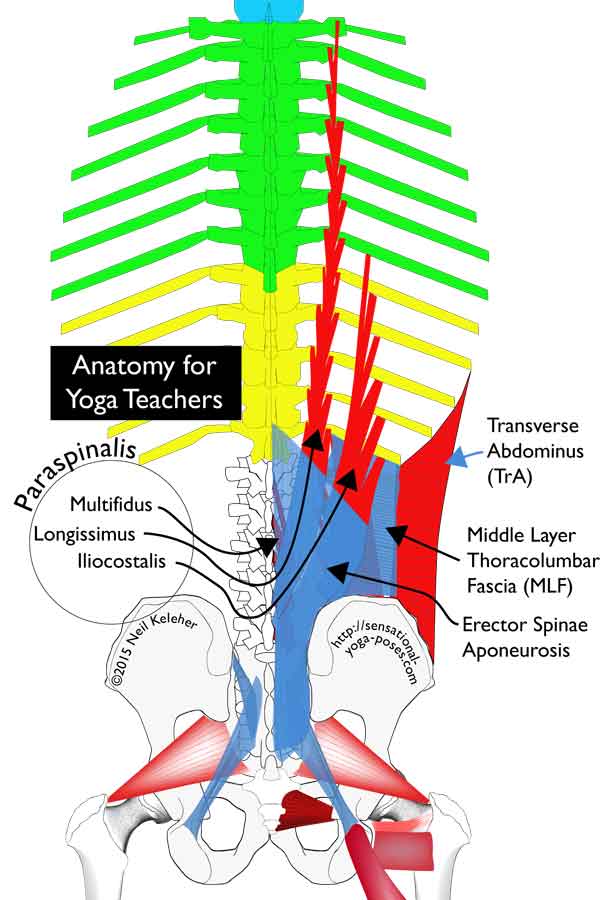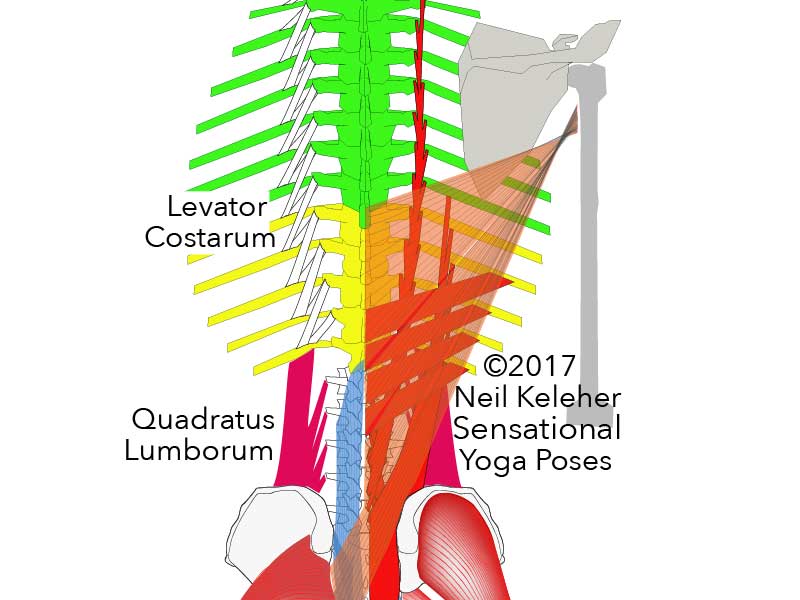Levator Costarum
Improve Thoracic Awareness and Mobility, Learn to Feel and Activate These Back Muscles
Levator Costarum can be used to "lift your back ribs."
Actually, your whole ribs will lift, but the back of your ribs will lift more. More importantly, it is an action you can learn to feel and deliberately do.
The advantages of using your Levator Costarum to lift your back ribs are that it can make it easier to bend your spine backwards when doing back bending yoga poses. You may also find that you can use this action to create deeper inhales.
Since muscle activation gives you a feel for your body or Proprioception, learning to activate your Levator Costarum will help increase awareness of the back of your body, particularly the thoracic spine and the back of your ribcage.
That being said, you may need some initial awareness of the back of the body to get this deeper awareness. And so you may find it helpful to start by learning to feel the front of your ribs. And for that Costal Breathing can be a good place to start.
The Spinal Erectors
A set of muscles that is closely related to the spinal erectors in terms of position is the Levator Costarum.

This picture shows the iliocostarum and longissimus muscles, both of which are part of the spinal erector group. The erector spinae aponeurosis is the like a giant multilayered tendon that connects to the spinal erector muscles.
The spinal erectors run down the back of the body along either side of the spine. The can be used to bend the spine backwards. They can also be used to resist the body bending forwards. If the spine is already bent forwards the spinal erectors could be used to support the back of the spine in this bent forwards position.
The Levator Costarum Muscles
The Levator Costarum lie along either side of the thoracic spine.

Levator Costarum on the left side, shown in white.
Comparing the two anatomy pictures above, you can see that where the longissimus muscle connects to the ribs from below, the Levator Costarum connects to them from above.
These two sets of muscles could be used in opposition to stabilize the back of the ribcage. Such an action can be useful because with both sets of muscles active, it gives us sensation that we can use to feel the back of our body.
Lifting the Back Ribs
The Levator Costarum can be used to lift the back ribs. These muscles reach down from each thoracic vertebrae to the first and second set of ribs directly below the relative vertebrae. The muscle bodies are located in a space about two to three inches either side of the center line of the spine.
If you can feel your spinal erectors activating in this region, then in may be relatively easy to then use a similar feeling to cause the back of the ribs to lift. One reason for this is that the spinal erectors, particularly the longissimus, can create a downwards pull on the ribs. This in turn may lengthen the Levator Costarum to an extent that they subsequently become easier to activate.
Another possibility is that with the spinal erectors active, the vertebral column is more stable and that gives the Levator Costarum a foundation from which they can effectively activate to create an upwards pull on the backs of the ribs.
The Muscles That Act Directly or Indirectly on the Ribcage
You can use your spinal erectors to cause the front of your ribcage to lift. This same action can be used for a version of costal breathing.
Simply bend your thoracic spine backwards and since the ribs are attached to the thoracic spine the front of the ribcage lifts and expands at the same time. In this action the intercostal muscles can be used to further expand the ribcage and also create sensations that we can interpret as "feeling the ribcage" or "feeling the ribs".
Note that costal breathing is often given a bad wrap. And actually there is a type of costal breathing where the result is that the ribcage moves up and down but without the ribcage changing shape. This action might be driven by a simple intent to pull or suck in the belly.
If the spinal erectors and intercostal muscles are used together to move the ribs then costal breathing can be quite deep and satisfying. (And in this case it might better be called vertebral-costal breathing.)
A different type of costal control that can be used to create a different costal breathing method is to use the Levator Costarum. And even if not focused on breathing, these muscles can be used to increase control of the ribcage.
The purpose of learning to control and feel any one set of muscles isn't to say that one set of muscles is better than the other, rather it is to learn to use them all so that they can all act freely when required, or so that you can choose which muscle to focus on given what your are trying to do.
Experiencing the Levator Costarum
If you can already feel and control your spinal erectors, especially in the area of the back of the ribcage, then the Levator Costarum may be easier to feel since the feeling of the muscles contracting is quite similar although the effect is different.
When contracting the spinal erectors, they try to bend the vertebral column backwards.
When contracting the Levator Costarum they try to cause the back ribs move away from the pelvis, or towards the head.
Start with slow rhythmic backbending of the spine using the spinal erectors to cause the spine to bend backwards as you inhale. Relax slowly each exhale.
Once you are comfortable with this action focus on reaching the back ribs upwards each time you inhale.
- Lengthen your neck first,
- pull your chin to your chest
- and then move your back ribs towards your head.
If you have a friend handy, you can have them place the palms of their hands on your back ribs. Have them slowly and slightly lift their hands as you inhale and try to move your ribs with their hands. Have them move their hands down while you exhale. And then you can switch.
You may notice that by lifting your back ribs, your entire ribcage lifts as a result. So that you know that you are using you Levator Costarum to cause this action, focus on pulling upwards on the back of the ribs (to either side of the spine.) The feeling is very similar to that of activating the erector spinae.
You may find that if you bend your thoracic spine forwards first, then try to lift your back ribs, the action is easier. You can then bend your thoracic spine backwards. To do this, follow the following steps:
- Pull your sternum back relative to your pelvis. The feeling is like you are pulling your ribcage backwards relative to your pelvis. Your upper back should round as a result.
- Lift your back ribs. The feeling is like your back is expanding.
- Bend your thoracic spine backwards.
- Relax and repeat.
Once you can lift your back ribs, play with the amount that you lift them. You may find tht you only have to lift them a little in order to bend your thoracic spine backwards. By becoming more sensitive, more aware, you'll find exactly how much you need to engage each set of muscles to get a desired result.
Using the Levator Costarum and Erector Spinae Together
The nice thing about using the Levator Costarum is that they help to create space in the back of the ribcage. They also help in opening the space either side of the lumbar spine by drawing the back ribs away from the pelvis. And they make it easier to bend the spine backwards because of the change in angle between the ribs and the spine.
This action can also cause some of the spinal erectors to lengthen, particularly those fibers that attach the pelvis to the back of the ribs, making it then easier to contract these same muscles.
Try doing wheel pose with or without the spinal erectors, but in either case while using the Levator Costarum. See for yourself whether this helps to deepen your backbend or at least make it more comfortable.
Because of all of these factors, it can often be helpful to use the Levator Costarum and spinal erectors together. The former create room so that we can bend the spine backwards while the latter cause the spine to bend backwards. But even in back bending postures where you aren't using the spinal erectors, using the Levator Costarum can still be beneficial, creating room for the thoracic spine to bend backwards passively.
Forward Bends
Apart from in backbends, where else might the spinal erectors and Levator Costarum be useful? In forward bends for the hips.
For beginners especially, and for anyone with tight hamstrings, the tendency in a standing or seated forward bend is to focus on bending the spine forwards in an effort to get the head to the knees. However, if you learn to feel you spinal erectors and when they are active, you can focus on keeping this feeling while at the same time tilting your pelvis forwards. In addition, if you keep your hands on the floor and slowly bend their elbows, you can use the weight of your upper body to slowly help to lengthen your hamstrings.
Activating Your Spinal Erectors in a Forward Bend?
If you do try engaging your spinal erectors while in a forward bend (or some variation of a forwards bend) I would strong recommend pulling your head back and up (relative to your ribcage) and you chin in towards your chest so that the back of your neck lengthens. You may find that this action helps to further accentuate opening your chest.
As a final note, when using the spinal erectors to bend the spine backwards while forward bending at the hips, you may find it helpful to engage the side glutes to widen the thighs slightly. Or you may find that this happens naturally when you bend your spine backwards.
If you do try this action, try reaching your thighs forwards at the same time, as if pulling your thigh bones our of your hip socket. Take some time to feel both the action and the result of the action. See if forward bending happens easier as a result.
More Lessons On Increasing Your Body Awareness
If you found the descriptions in this post helpful for learning to activate and feel your Levator Costarum (and spinal erectors) activating, I've created driving lessons for your body. This set of courses include exercises that I've tested and used in my classes to help my students improve control and awareness of their own body.
Published: 2020 08 27




